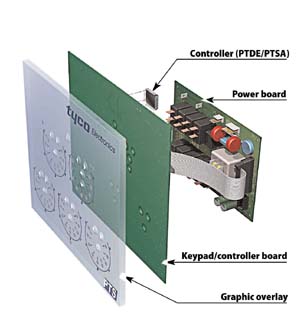October 2, 2003
Originally Published MPMNOctober 2003
INDUSTRY NEWS
New Visions in Touch Screen Technology
|
Mediflex compounds Padless touch sensor technology from Tyco Electronics has an open architecture that allows for easy integration (Click to enlarge). |
Norbert Sparrow
The history of touch screens essentially has been a tale of two technologies. Resistive systems allow input from a finger as well as almost any other object. Capacitive technology is more durable and provides clearer graphics, but it requires a conductive input, generally a finger, to operate. The lower cost of resistive technology and its input flexibility has led to its dominance in the marketplace. This is especially true in the medical environment, where users often wear gloves. Two new approaches to touch screen electronics may expand options for OEMs, however. Touch International (Austin, TX; www.touchinternational.com)has developed a technology that, it says, combines the best of both worlds and has none of the drawbacks. Multinational giant Tyco Electronics (Harrisburg, PA www.tycoelectronics.com) has introduced a technology that allows touch sensitivity to be adjusted.
A thin form-fitting touch screen-line, Digital Ink from Touch International allows stylus, finger, and gloved-hand input. A palm-rejection feature prevents accidental data entry. Digital Ink touch screens are currently available in sizes up to 5.7 in. diagonal. Larger sizes will be on the market by the end of this year. The design is the brainchild of company cofounder Gary Barrett, who invented the five-wire resistive touch screen in 1984. "Once scaled up to larger size touch screens, I believe this will revolutionize the industry," says Barrett.
The glass or plastic sensor material is available in thicknesses from 0.36 to 50.8 mm. Thin, power efficient, and lightweight, the touch screens open up new opportunities in product design, according to the firm.
For its part, Tyco Electronics has grand designs for a Padless Touch Sensor (PTS). The firm has a worldwide licensing agreement with Pressnek Instruments (Montreal, QC, Canada) to market the solid-state technology. Using proprietary signal generation and detection, PTS is an alternative to other switch methods. It has an open architecture that enables easy integration or retrofitting.
|
Touch International has introduced what it calls the world's thinnest form-fitting unbreakable touch screen. |
The touch surface can be made from almost any dielectric material less than 25 mm thick. Touch sensitivity is adjustable, allowing actuation with a gloved hand. The surface area can be designed to customer specifications. Environmental sealing to IP67 standards is available, and the device can operate in temperatures from -20° to 105°C. There is no mechanical link between the touch pad and the electronics, resulting in a product life of more than 5 million touch cycles.
Discrete electronic components as well as ASICs can be supplied. The company can also provide turnkey electronic systems that couple PTS with control and power-switching components.
For more information on Digital Ink, contact Touch International, One Chisholm Trail, Ste. 3200, Round Rock, TX 78681; phone: 512/388-0090; fax: 512/388-0094; e-mail:[email protected]; Internet: www.touchinternational.com.
To learn more about PTS technology, contact Tyco Electronics, P.O. Box 3608, Harrisburg, PA 17105; phone: 800/522-6752; fax: 717/592-6146; e-mail: [email protected];Internet: www.tycoelectronics.com
Copyright ©2003 Medical Product Manufacturing News
You May Also Like




